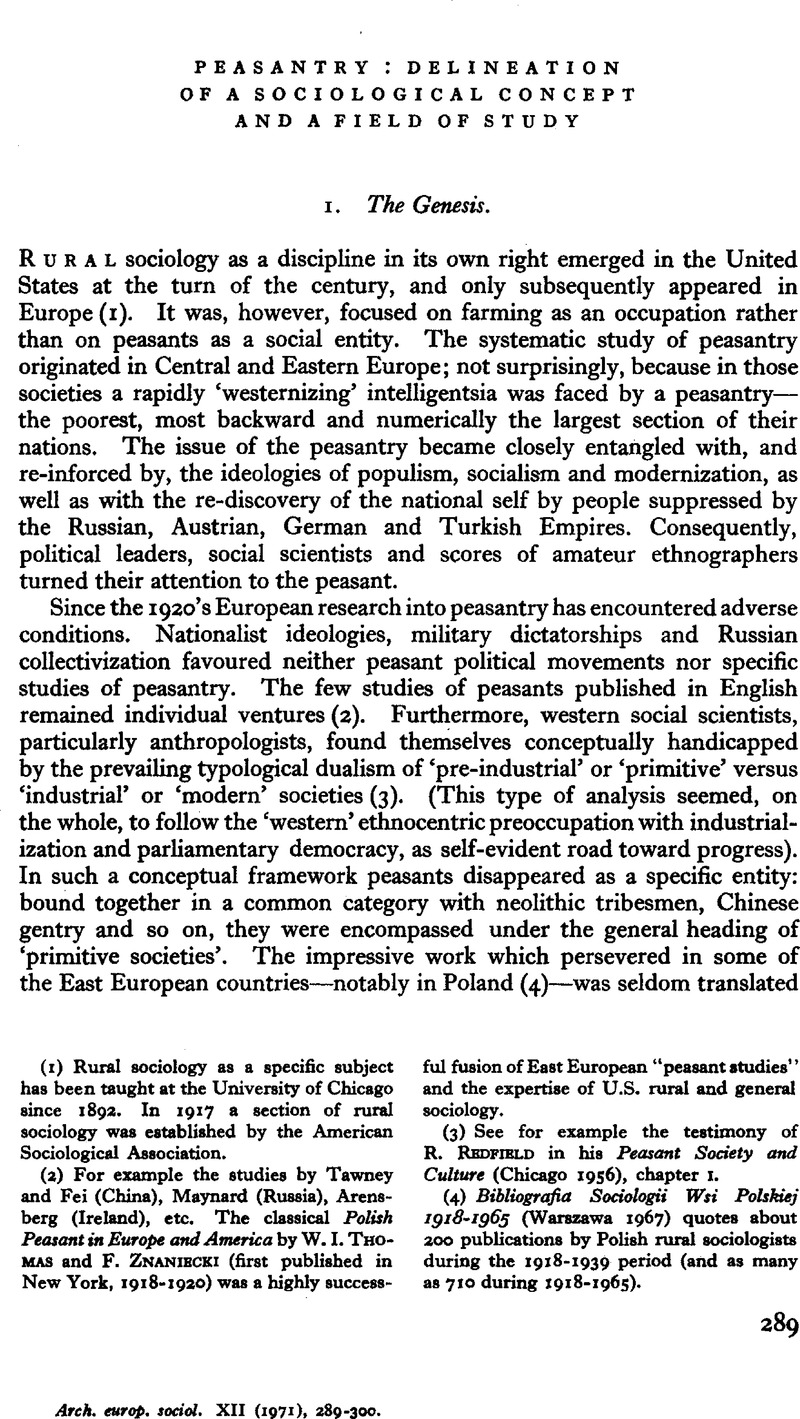Published online by Cambridge University Press: 28 July 2009

(1) Rural sociology as a specific subject has been taught at the University of Chicago since 1892. In 1917 a section of rural sociology was established by the American Sociological Association.
(2) For example the studies by Tawney and Fei (China), Maynard (Russia), Arensberg (Ireland), etc. The classical Polish Peasant in Europe and America by Thomas, W. I. and Znaniecki, F. (first published in New York, 1918–1920)Google Scholar was a highly success-ful fusion of East European “peasant studies” and the expertise of U.S. rural and general sociology.
(3) See for example the testimony of Redfield, R. in his Peasant Society and Culture (Chicago 1956), chapter IGoogle Scholar.
(4) Bibliografia Sociologii Wsi Polskiej 1918–1965 (Warszawa 1967)Google Scholar quotes about 200 publications by Polish rural sociologists during the 1918–1939 period (and as many as 710 during 1918–1965).
(5) Mithany, D., Marx against the Peasant (New York 1961)Google Scholar.
(6) Redfebld, , op. cit. p. 25Google Scholar.
(7) Erasmus, C., Upper Limits of Peasantry and Agrarian Reform: Bolivia, Venezuela and Mexico Compared, Ethnology, XI (1967), p. 350Google Scholar.
(8) Weber, Max, The Theory of Social and Economic Organisation (London 1964), pp. 109–110Google Scholar.
(9) For an elaboration of the differences see Ossowski, S., Class Structure in the Social Consciousness (London 1963)Google Scholar.
(10) For an excellent presentation of the case see Mandel, E., Marxist Economic Theory (London 1968)Google Scholar.
(11) For an exemple see Ahrighi, G. and Saul, J. S., Socialisms and Economic Development in Tropical Africa, Journal of Modern African Studies, VI (1968), 141–196CrossRefGoogle Scholar.
(12) Marx, Karl, Pre-capitalist Economic Formation (London 1965)Google Scholar, also volume III of Capital; Vasilichakov, A., Sel'skii Byt i Sel'skoe Khoxyaistvo v Rosii (St. Petersburg 1881)Google Scholar.
(13) For amplification see Boeke, J. H., Economics and Economic Policy of Dual Society (New York 1953)Google Scholar.
(14) Firth, R., Human Types (London 1960)Google Scholar; Nash, M., Primitive and Peasant Economic Systems (San Francisco 1966)Google Scholar; Chayanov, A. V., The Theory of Peasant Economy (Homewood 1966)Google Scholar.
(15) Pierce, A., The Latin American Peasant (London 1971)Google Scholar.
(16) Potter, J., Diaz, M. N. and Foster, G. M., Peasant Society (Boston 1967), p. 17Google Scholar.
(17) Durkheim, é., The Division of Labour in Society (first published in 1893)Google Scholar.
(18) Kroeber, A. L., Anthropology (New York 1948), p. 248Google Scholar.
(19) Smelser, N. J., Theory of Collective Behaviour (London 1962)Google Scholar; Eisenstadt, S.N., Modernization: Protest and Change (Engle-wood Cliffs 1966)Google Scholar.
(20) Wolf, E., Peasants (Englewood Cliffs 1966)Google Scholar; see also fn 25 below.
(21) Galeski, B., Rural Sociology (Man-Chester 1971)Google Scholar.
(22) Moore, Barrington Jr, Social Origins of Dictatorship and Democracy (Boston 1966)Google Scholar; Hobsbawm, E., Primitive Rebels (Manchester 1959)Google Scholar; Thorner, D., Peasant Economy as a Category of Economic History, IIe Confiérence Internationale d'histoire éonomique [Aix-en-Provence], II (1962), 287–300Google Scholar, repr. in Economic Weekly [Bombay] (1963), special issue: Warriner, D., Economics of Peasant Farming (London 1964)Google Scholar, as well as her studies of agrarian reform.
(23) Culture is here used not in its fullest anthropological sense (i.e. as the opposite of Nature), but as “the lens […] through which men see; the medium by which they interpret and report what they see”. Cf. Mills, Wright, Power, Politics and People (New York 1962)Google Scholar.
(24) See for example Foster, G.F., Peasant Society and the Image of Limited Good, American Anthropologist, LXVII (1965), 293–315CrossRefGoogle Scholar; Bailey, F. G., The Peasant View a Bad Life, Advancement of Science, XII (1966), 399–409Google Scholar. For a different view see Ortiz, S., The Structure of Decision-Making, in Firth, R., Themes in Economic Anthropology (London 1967)Google Scholar.
(25) See Wolf, E., Aspects of Group Relations in a Complex Society, American Anthropologist, LVIII (1956), 1065–1078CrossRefGoogle Scholar; also Shanin, T., The Awkward Class (Oxford 1971), part IIIGoogle Scholar.
(26) For elaboration see Wolf, E., On Peasant Rebellions, International Social Science Journal, XXI (1969)Google Scholar; also Shanin, T., Peasantry as a Political Factor, Sociological Review, XIV (1966), 5–27CrossRefGoogle Scholar.
(27) Redfield, (op. cit. p. 20) seemed to refer to some of such groups as ‘edges’ of the peasantryGoogle Scholar.
(28) See, for example, the evidence collectrefered in Franklin, S., The European Peasantry (London 1969)Google Scholar.
(29) Shanin, The Awkward Class, op. cit. part II; Robertshaw, S., Emigration in the Irish Peasant Communities (1968) [an unpublished manuscript]Google Scholar.
(30) For discussion see Galeski, B., Sociological Problems of the Occupation of a Farmer, The Annals of Rural Sociology (1968), special issue, pp. 9–26Google Scholar.
(31) For current discussion see Worsley, P. (ed.), Two Blades of Grass (Manchester 1971)Google Scholar.
* A partial and much abbreviated version of the above discussion is used in the Introduction to Peasants and Peasant Societies, a reader in the Penguin Modern Sociology Series. A paper along these lines was discussed in 1969 by the Sociology of Developing Societies Group of the British Sociological Association.